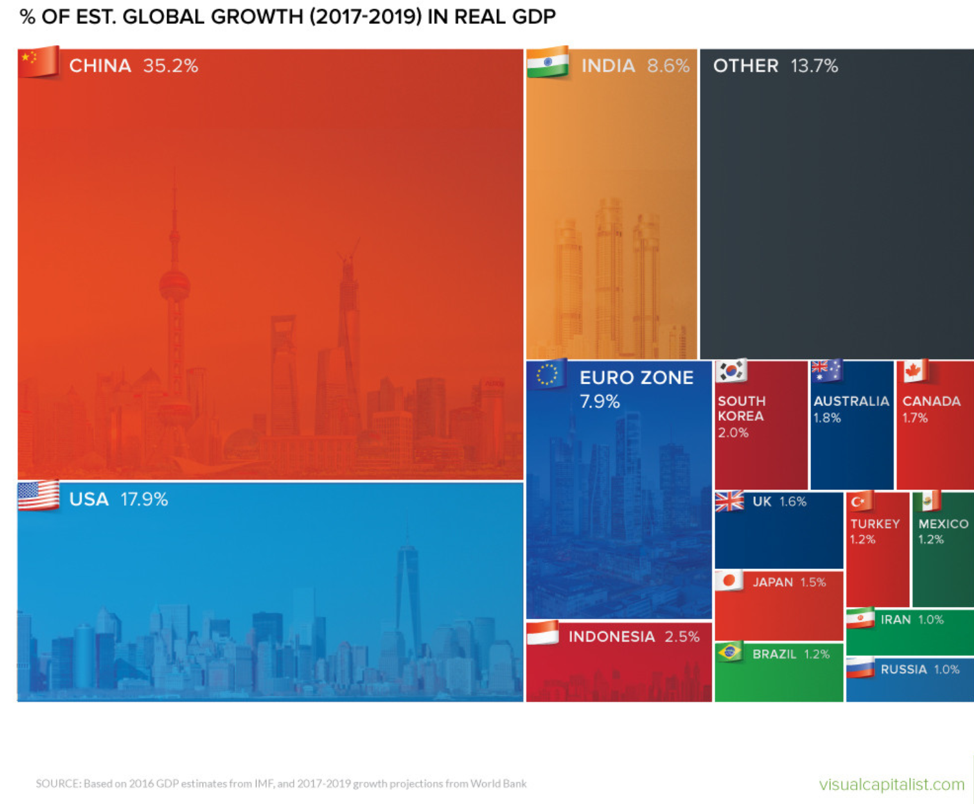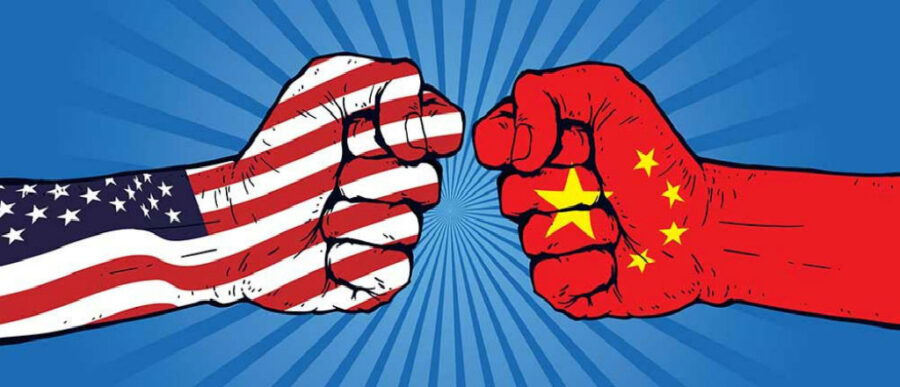With each passing day, the U.S.-China standoff is looking less like a trade war and more like a “new cold war” between the world’s two most powerful countries, writes Wharton Dean Geoffrey Garrett in this opinion piece.
With escalating threats of higher American tariffs on more Chinese imports, followed inevitably by Chinese tit-for-tat retaliation on American exports, talk of a trade war is everywhere. But the Trump administration’s strategy is about far more than trying to level the playing field in trade, with potentially much worse consequences for both countries, and for the global economy and global stability.
The U.S. claims that Chinese trade is unfair — because of government subsidies, restricted American access to the Chinese market, and manipulation of the Chinese currency, among other things — and hence merits tough tariffs. But that is only the beginning.
The Trump administration goes on to assert that the entire Chinese model of economic development is illegitimate, and antithetical to the open and free global economy supported by the U.S. – because the Communist Party government’s reach extends to every aspect of the Chinese economy.
Add to this the last Trump contention: China’s aspirations to become a global leader in technology are a threat to American “national security” because so much of modern technology is potentially “dual use,” with both commercial and military applications.
While pre-Trump policy was constantly looking for win-wins with China, Trump believes there are no win-wins, only win-loses. For America to win, China must lose.
With each escalating assertion, the situation is looking less like a trade war and more like a “new cold war” between the world’s two most powerful countries.
Here are some of the unprecedented tools the U.S. is marshaling to use against China:
- Section 301 of the 1974 Trade Act justifying American tariffs because Chinese practices are “unreasonable” and “restrict U.S. commerce.”
- Section 232 of the 1962 Trade Expansion Act giving the U.S. the right to impose tariffs because Chinese behavior is a “threat” to American “national security.”
- The U.S. National Security Strategy, which late last year labeled China a “revisionist power” determined to undermine the U.S.-led global order.
Less noticed, but at least as important, are other recent American actions against Chinese (and China-influenced) companies, all of which the administration based on national security grounds:
- Blocking Alibaba’s acquisition of MoneyGram
- Outlawing the sale of ZTE and Huawei phones in America
- Blocking the Broadcom-Qualcomm merger
This is a radical departure from the clear and consistent central tendency of American policy towards China since Richard Nixon first went to Beijing over 40 years ago. No matter who has been in the White House since then, the consensus position has been that the best way for America to further its national interests is to increase economic interconnections with China.
This has been viewed as a win-win-win for the U.S.: good for the American economy, good for promoting economic and political reform in China, and good for global peace and stability by tying China into the global system.
Then-President Bill Clinton made this case explicitly in his successful push to get China into the World Trade Organization. Here is what he said in a speech in March 2000:
By joining the WTO, China is not simply agreeing to import more of our products, it is agreeing to import one of democracy’s most cherished values, economic freedom … When individuals have the power not just to dream, but to realize their dreams, they will demand a greater say.
Fast forward to today. The Trump team has just written to the WTO about the threat China poses to the organization, and to the global economy — a 180-degree about-face from the Clinton position:
Since joining the WTO, China has repeatedly signaled that it is pursuing economic reform. Unfortunately … [for] China, economic reform means perfecting the government’s and the Party’s management of the economy and strengthening the state sector, particularly state-owned enterprises. As long as China remains on this path, the implications for this organization are decidedly negative.
This is just part of Trump’s essential repudiation of the entire post-Nixon consensus on China.
“[The] Trump administration’s strategy is about far more than trying to level the playing field in trade, with potentially much worse consequences for both countries, and for the global economy.”
According to Trump, American economic engagement has neither increased political freedoms in China nor reduced the government’s role in the economy. Indeed, things have gone backwards under President Xi Jinping, this thinking goes. China’s rise has cost countless good American jobs without giving American companies and products enough access to the Chinese market, he argues.
Moreover, Trump contends, China is determined to acquire American IP and know-how by any means necessary to ramp up its technological sophistication, which it in turn will use to drive its military power and global influence.
While pre-Trump policy was constantly looking for win-wins with China, Trump believes there are no win-wins, only win-loses. For America to win, China must lose.
With the exception of Treasury Secretary Steve Mnuchin, you will rarely hear anyone on the Trump team acknowledge the clear benefits the U.S. has derived from being so involved in China’s economic rise in the last four decades:
- Cheaper and more plentiful products assembled, made or sourced in China — from all the “made in China” products on Walmart shelves to every Apple device: a win for the American consumer.
- A growth market for American multinationals — think not only Boeing planes made in the U.S., but also General Motors vehicles made in China: a win for American companies.
- Lower U.S. interest rates because of well over $1 trillion in Chinese savings poured into U.S. Treasury bills: a win for the American economy.
Instead, the Trump team makes a different point. Even if the U.S. has benefitted in some ways from China’s economic rise, China has gained much more.
There is no doubt relatively open access to the American market has been the major driver of Chinese economic growth since at least its entry into WTO — a major win for China. At the same time, access to the Chinese market has always come with real strings attached for American firms.
So, what should the U.S. do about this underlying asymmetry in U.S.-China economic relations?
The traditional American approach in seeking to increase access to the Chinese market has been more carrot than stick, more encouragement in private than public calling out, more rhetorical cajoling than tariffs and sanctions. Prior presidents have shared Trump’s objectives. They have just gone about trying to achieve them very differently.
“While pre-Trump policy was constantly looking for win-wins with China, Trump believes there are no win-wins, only win-loses. For America to win, China must lose.”
Trump’s approach is the exact opposite — lots of sticks and very few carrots. A one-two punch of open public criticism and tough unilateral policy moves.
So, what will be the consequences of Trump’s about-face on China?
America may win the trade war (i.e., getting some concessions from China) in the short term because its bargaining position is stronger. The Chinese economy is looking more fragile today than in the past 20 years, whereas the American economy is very strong. Access to the American economy is more important to China than access to the Chinese economy is to America. China probably has no alternative than to make some concessions to the U.S. These concessions are probably in China’s long-term interests, anyway.
But if Trump wins some concessions in the trade war, he should stop there. Escalating his attacks on China towards a new cold war would be a lose-lose of gargantuan proportions.
Efforts to quantify the costs of the trade war begin with the costs to American consumers of higher priced goods but quickly move to label the trade war as something that could potentially tip the American economy into recession. I don’t see that happening.
But take the Trump administration’s position to its logical conclusion: Because the Chinese economy is unfair, illegitimate and a threat to American national security, the U.S. should reverse 40 years of economic engagement and systematically reduce the connections between the two economies.
Here is the fundamental difference between America’s cold war with the Soviet Union and its conflict with China today: The Soviet economy was completely isolated from, and irrelevant to, the Western economy led by the U.S.
In no small measure because of U.S. policy since Nixon, China today is absolutely at the core of today’s global economy. As the graph below indicates, China today accounts for more than one-third of all economic growth in the world. The U.S. simply cannot afford to turn its back on China.

So, my advice to the Trump administration is simple. You have some real and legitimate beefs about the Chinese economy. You probably are in a stronger bargaining position to get some concessions than in recent years.
But the risks to the global economy of a full-frontal attack on the Chinese economy are incalculable. There is a reason U.S. policy has been so consistent for so long — it is in America’s interests for China to do well. Rather than bluster on Twitter and make precipitous policy threats, it’s better to remember then-President Theodore Roosevelt’s motto for the U.S. more than 100 years ago: “Speak softly and carry a big stick.”
(This article originally appeared on LinkedIn.)



